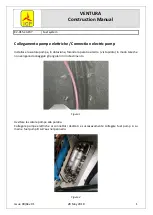
SECTION 3
CESSNA
EMERGENCY PROCEDURES
MODEL 172RG
TABLE OF CONTENTS (Continued)
Page
AMPLIFIED PROCEDURES
Engine Failure..................................................................................................3-11
Forced Landings.............................................................................................. 3-12
Landing Without Elevator Control .............................................................. 3-12
Fires ....................................................................................................................3-12
Emergency Operation In Clouds (Vacuum System Failure) .
3-13
Executing A 180° Turn In Clouds
3-13
Emergency Descent Through Clouds
3-13
Recovery From A Spiral Dive
3-14
Inadvertent Flight Into Icing Conditions ...................................................3-14
Static Source Blocked
3-15
Spins...................................................................................................................3-15
Rough Engine Operation Or Loss Of Power............................................. 3-16
Carburetor Icing
3-16
Spark Plug Fouling
3-16
Magneto Malfunction
3-16
Engine-Driven Fuel Pump Failure
3-16
Low Oil Pressure
3-17
Landing Gear Malfunction Procedures .......................................................3-17
Retraction Malfunctions
3-17
Extension Malfunctions
3-18
Gear Up Landing
3-18
Electrical Power Supply System Malfunctions ........................................3-18
Excessive Rate Of Charge
3-19
Insufficient Rate Of Charge
3-19
CESSNA
SECTION 3
MODEL 172RG
EMERGENCY PROCEDURES
INTRODUCTION
Section 3 provides checklist and amplified procedures for coping with
e mergencies that may occur. Emergencies caused by airplane or engine
malfunctions are extremely rare if proper preflight inspections and
maintenance are practiced. Enroute weather emergencies can be minim-
ized or eliminated by careful flight planning and good judgment when
unexpected weather is encountered. However, should an emergency arise,
the basic guidelines described in this section should be considered and
applied as necessary to correct the problem. Emergency procedures
associated with ELT and other optional systems can be found in Section 9.
AIRSPEEDS FOR EMERGENCY OPERATION
Engine Failure After Takeoff:
Wing Flaps Up ...................................................................................70 KIAS
Wing Flaps Down............................................................................. 65 KIAS
Maneuvering Speed:
2650 Lbs .............................................................................................106 KIAS
2250 Lbs ...............................................................................................98 KIAS
1850 Lbs ...............................................................................................89 KIAS
Maximum Glide:
2650 Lbs ...............................................................................................73 KIAS
2250 Lbs ...............................................................................................67 KIAS
1850 Lbs ...............................................................................................61 KIAS
Precautionary Landing With Engine Power......................................65 KIAS
Landing Without Engine Power:
Wing Flaps Up ...................................................................................75 KIAS
Wing Flaps Down ............................................................................. 65 KIAS
OPERATIONAL CHECKLISTS
ENGINE FAILURES
ENGINE FAILURE DURING TAKEOFF I
1.
Throttle -- IDLE.
2.
Brakes -- APPLY.
3.
Wing Flaps -- RETRACT.
4.
Mixture -- IDLE CUT-OFF.
5.
Ignition Switch -- OFF.
6.
Master Switch -- OFF.
1 July 1979
3-3
3-2
1 July 1979
















































